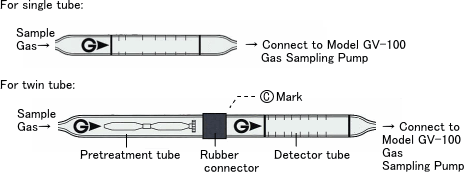| Name and chemical formula | The name of the substance to be measured with this detector tube and its chemical formula | ||||||||||||
| Detector tube number | The identification number of the detector tube | ||||||||||||
| External appearance | The external appearance of the detector tube(s) is briefly illustrated. Both ends of the tube(s) should be broken and prepared before measurements as shown below |
||||||||||||
| Measuring range | The range of the substance concentrations that can be measured with the detector tube. The standard measuring range, or range of the printed calibration scale is given in the shaded box. Some lower limit values of the standard measuring ranges are parenthesized when they are not printed on the tubes but only their scale lines are printed. | ||||||||||||
| Number of pump strokes | The number of pump strokes required for measuring a given range of concentrations. The volume to be sampled with those strokes is given in the parentheses. The standard pump strokes and the standard sampling volume are given in the shaded box. With most Gastec detector tubes,the standard pump strokes are prescribed as 1 (the standard sampling volume is 100 mL). | ||||||||||||
| Correction factor | When measuring an extended range of concentration, that is, when the measurement is performed with other than the standard number of pump strokes, the tube reading should be corrected by multiplying the reading by the prescribed correction factor. | ||||||||||||
| Sampling time | A waiting time for 100 mL (or 50 mL for half strokes) to be sampled in the detector tube after the handle of the Model GV-100 Gas Sampling Pump is fully (or half way for 50 mL) pulled out. When you pump more than once (n times), the waiting time for you to read the tube, that is, the measuring time is: Measuring time = sampling time x n. |
||||||||||||
| Detecting limit | The lower limit of the substance concentration that the detector tube can detect. This minimal concentration can be recognized by a slight colour change at the entrance of the detecting layer. This value is followed by the parenthesized number of pump strokes required for measuring this concentration. | ||||||||||||
| Colour change | Indicates how the detecting layer of the detector tube will change its colour by the reaction with the target substance. This is shown in the form of: Original → Changed colour |
||||||||||||
| Reaction principle | The chemical reaction of the target substance with the reagent(s) in the detector tube is briefly stated. | ||||||||||||
| Coefficient of Variation | An indicator of the accuracy of the detector tube. It represents how the tube indications may deviate from their mean value in percentage:
|
||||||||||||
| Shelf life | The period that Gastec will warrant the quality of the detector tubes, provided that they are stored under the prescribed conditions | ||||||||||||
| Corrections for temperature & humidity | For detector tubes whose indications are affected +/- 10 % or more by the fluctuation of temperature or humidity, the tube readings should be corrected. Whether or not such corrections are necessary are indicated here. The correction data, if necessary, is provided in the instruction sheets provided with the detector tubes. |
||||||||||||
| Storage condition | To keep the high quality of Gastec detector tubes, it is necessary to store them in a cool and dark place. It is recommended to store the tubes in the refrigerator, i.e, 0 to 10ºC(32 to 50ºF) even if the tube labels describes cool and dark place. | ||||||||||||
| Possible coexisting substances and their interferences | Substances that are liable to
coexist with the target substance and their influences on the tube indications are listed here. The column "Concentration"
Iists the lowest concentration that may affect the indication +/-10
% or more,
or the highest concentration that is assured of no influence to such
extent. These concentration levels are expressed either as quantitative ratios of interferents to the target substance (e.g., |
||||||||||||
| Other substance (s) measurable with this detector tube | Some detector tubes have high sensitivities to several other substances and can be used to measure those concentrations. If this is the case, the names of such substances, the correction methods of the tube readings (whether by using a correction scale or a correction factor), the numbers of pump strokes and the measuring ranges are listed. For detector tubes that perform qualitative analysis, the title of this item is read as "Substances measurable with this detector tube." | ||||||||||||
| Calibration gas generation | The method of generating the calibration gas that is used for calibrating the detector tube or testing its accuracy. | ||||||||||||
| Threshold limit values and explosive range | Some substances may be hazardous to health or dangerous to life
depending on their concentrations or the duration of exposure, or may
be combustible or explosive. For detector tubes for measuring those
substances, the threshold limit values based upon the recommendations
of the American Conference of Governmental Industrial Hygienists
(ACGIH), as well as the explosive ranges are presented for your reference.
|
||||||||||||